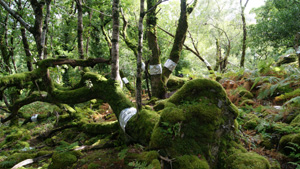Slugs do not have a good public profile and most would consider them at best unpleasant and at worst, pests. The Kerry Slug cannot be accused of being a pest as it is only found in the wild landscapes of the south and west. The animals themselves are attractively marked with white or cream spots on a black or brown background. Black slugs predominate in heathlands, whereas the brown form is only found in woodlands. However this is not fixed and the black slugs can be seen in wooded areas.
A three-year research project has been completed on the Kerry Slug, the first of its kind on the species. This has developed a safe method of trapping and locating slugs using baited refuge traps. The project also provided information on the movements of slugs in woodland and on boulder fields. Unsurprisingly, the research found that most slugs do not appear to move far. However more information is needed to determine whether the species can recolonise areas it has become extinct in.

Kerry slug traps (Photo: B. Nelson)
One significant finding was that, contrary to previous opinion, the Kerry Slug was found in coniferous woodland often at quite high densities. This has implications for the species as it means that there is potentially more habitat for it but that as a legally protected species, the impact of forestry operations need to be mitigated for.
The findings of the first research project have been published as an Irish Wildlife Manual No. 54 ![]() [4,832KB]. More research is being undertaken with NPWS funding on the distribution of Kerry Slug in conifer plantations and the impact of clear felling on these populations. National University of Galway is also carrying out research on the diet and genetics of the species.
[4,832KB]. More research is being undertaken with NPWS funding on the distribution of Kerry Slug in conifer plantations and the impact of clear felling on these populations. National University of Galway is also carrying out research on the diet and genetics of the species.
